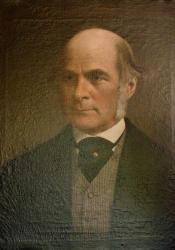"The History of Twins" by Francis Galton
The character of Eshton, a house guest of Rochester’s, in Susanna White’s adaptation of Jane Eyre seems to have a great deal of interest in studying twins. Throughout the series, he is seen constantly questioning the Dent twins. Eshton perhaps plays a role in showing the types of studies that were occurring during this time period. One of the most notorious twin studies conducted was by Francis Galton. Galton published his article “The History of Twins” in 1875 and it is said to “represent[..] the first detailed attempt to use the phenomenon of twinning to estimate the relative powers of nature and nurture” (Waller). The debacle between nature vs. nurture was an important argument during the 1800s and continues to be so. The question was whether who we are as people lies more in the genetics we were born with or how we were raised and the experiences we had in life. Galton’s study focused on researching this question through the use of twins.
Galton ultimately concluded from his study “that nature has a larger effect than nurture on development” (Bahjat). Ultimately, he believed that the way twins were born was more determining in the people they would become. This means that if a set of twins were born to be similar, they would continue to be similar even if they were raised differently, and vice versa (Bahjat). This study seems to support the character of Eshton’s beliefs in the film. He seems to believe strongly in the idea of nature over nurture, especially when it comes to the twins he studies. He poses the question to Rochester as he is leaving: “Well, you don’t think it possible that two minds can be so in tune that they communicate across the country, and call out to each other across space and time?” (Jane Eyre 17:10-19). However, this comment seems to extend past the idea of twins, and more closely focus on the relationship between Rochester and Jane.
This quote appears to be foreshadowing for when Jane hears Rochester's call out to her while she is staying with St. John. As we later learn, Rochester indeed did call out to her and it wasn’t all in her head. The metaphor of being “twins” is used continuously throughout the film in reference to Rochester and Jane, specifically by Rochester himself. He remarks to Jane, “And you and I, it’s like we’re a pair of Eshton’s twins. Bound together in some unwordly way, sharing a spirit we’re so alike” (Jane Eyre 28:35-46). From this and from Galton’s study in 1875, we can see the popular question of nature vs. nurture being applied directly to Jane and Rochester. We might even add class as a factor to all of this; despite Rochester and Jane being raised very differently and going through different experiences, what they were born with (their very nature) is what makes them so similar. Though not actually twins, there is a theme interwoven here that is saying that even with all their physical differences, Jane and Rochester have similar “spirits.” In this way, it is supporting Galton’s conclusion that nature has a larger effect on who Jane and Rochester are than nurture (how they were raised) and this is what connects them, despite all their class and age differences.
Works Cited
Bahjat, Mudhaffar, "“The History of Twins, As a Criterion of the Relative Powers of Nature and Nurture” (1875), by Francis Galton". Embryo Project Encyclopedia (2017-12-19). ISSN: 1940-5030 http://embryo.asu.edu/handle/10776/13029.
Jane Eyre. Directed by Susanna White, British Broadcasting Corporation (BBC), 24 September 2006.
Waller, John C. “Commentary: The birth of the twin study—a commentary on Francis Galton’s ‘The History of Twins.’” International Journal of Epidemiology, vol. 41, no. 4, August 2012, https://doi.org/10.1093/ije/dys100. Accessed 19 March 2022.
Image Citation
Sir Francis Galton (1822-1911), FRS. 1860. Historic England Archive. English Heritage, Down House. https://artuk.org/discover/artworks/sir-francis-galton-18221911-frs-194337

